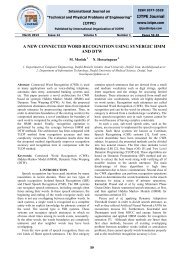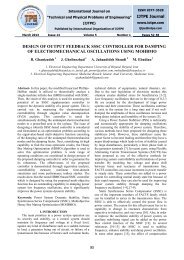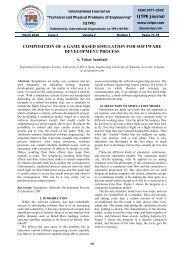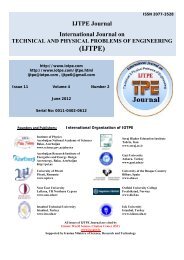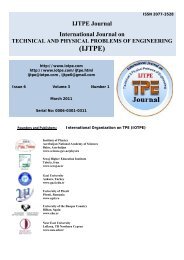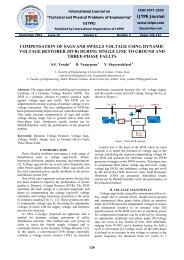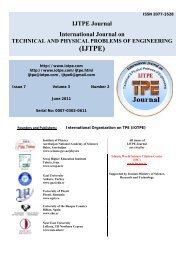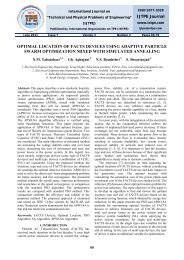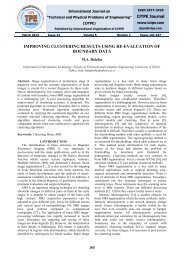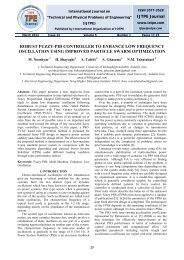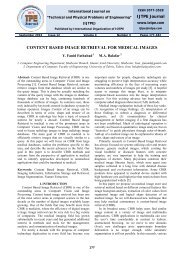15-IJTPE-Issue9-Vol3-No4 - iotpe
15-IJTPE-Issue9-Vol3-No4 - iotpe
15-IJTPE-Issue9-Vol3-No4 - iotpe
Create successful ePaper yourself
Turn your PDF publications into a flip-book with our unique Google optimized e-Paper software.
International Journal on<br />
“Technical and Physical Problems of Engineering”<br />
(<strong>IJTPE</strong>)<br />
Published by International Organization on TPE (IOTPE)<br />
ISSN 2077-3528<br />
<strong>IJTPE</strong> Journal<br />
www.<strong>iotpe</strong>.com<br />
ijtpe@<strong>iotpe</strong>.com<br />
December 2011 Issue 9 Volume 3 Number 4 Pages 97-101<br />
MODELING AND CONTROL OF WIND TURBINE AND FAULT<br />
A. Nayir 1,2 E. Rosolowski 2 L. Jedut 2<br />
1. Fatih University, Istanbul, Turkey, anayir@fatih.edu.tr<br />
2. Institute of Electrical Power Engineering, Wroclaw University of Technology, Wroclaw, Poland<br />
leszek.jedut@pwr.wroc.pl, eugeniusz.rosolowski@pwr.wroc.pl<br />
Abstract- This paper deals with the modeling of doubly<br />
fed induction generator (DFIG) cooperating with wind<br />
turbine. The wind turbine and the DFIG models are<br />
presented step by step. Overall control system of the<br />
DFIG is modeled in details in program ATP-EMTP. A<br />
breakdown on the model was formed thanks to phaseground<br />
short circuit. Active and reactive power curved<br />
lines and stator voltage curved lines were observed.<br />
Keywords: Induction Generator, Wind Turbine,<br />
Converter AC/AC, Power System.<br />
I. INTRODUCTION<br />
Wind energy is one of the most important and<br />
promising sources of renewable energy all over the<br />
world. It is connected with reduction of CO 2 , NO x , SO 2<br />
emissions generated by traditional fossil fuel and<br />
economical considerations. Combined with other<br />
renewable technologies and efficient energy use, wind<br />
power is crucial in reducing global climate change, acid<br />
rain and other environmental problems, because it<br />
produces no carbon dioxide (a gas that contributes to<br />
global warming), sulphur dioxide or nitrogen oxides<br />
(gases that contribute to acid rain), and hazardous or<br />
radioactive wastes. Global climate change and<br />
greenhouse effect the history of the planet shows that<br />
climate changes occur from time to time in different parts<br />
of the world. The greenhouse effect can be defined<br />
briefly as an atmospheric temperature increase, due to gas<br />
emitted by human activities. Emissions of the main<br />
anthropogenic greenhouse gas, CO 2 , are influenced by:<br />
size of the human population, amount of energy used per<br />
person, and level of emissions resulting from energy use.<br />
Wind turbine technology with wind energy economics<br />
and wind systems are evaluated. Wind energy current<br />
states are given year by year for some countries where<br />
electricity generation by wind energy increases in an<br />
unprecedented manner.<br />
According of Concept European Union in 2010 year<br />
power of installed in renewable energy should be<br />
75000MW and 2020 should achieve <strong>15</strong>0000 MW [1, 2].<br />
So at same time, there has been a rapid development wind<br />
technology [3, 4]. With increased penetration of wind<br />
power into electrical grids, DFIG wind turbines are<br />
largely deployed due to their variable speed feature and<br />
hence influencing system dynamics. This has created an<br />
interest in developing suitable models for DFIG to be<br />
integrated into power system studies. The continuous<br />
trend of having high penetration of wind power, in recent<br />
years, has made it necessary to introduce new practices.<br />
The main advantage of the DFIG include: wide range of<br />
control of the output power extracting from the wind,<br />
separate active and reactive power control and relatively<br />
fast response to significant grid disturbances [5, 6].<br />
Industry requires engineers to model a system before<br />
they are allowed to perform experiments. After<br />
developing an analytical model an experimental test plan<br />
was conducted to provide necessary and sufficient data to<br />
improve the accuracy of the analytical model. In this<br />
study active, reactive and stator curved lines in a wind<br />
turbine which was modelled in [7] reference, in case of<br />
any breakdown, have been observed.<br />
II. MATHEMATICAL MODEL OF GENERATOR<br />
AND WIND TURBINE<br />
Functions approximation is a way of obtaining<br />
relatively accurate representation of a wind turbine. It is<br />
made by using a few parameters which represent model<br />
of wind turbine. It is current source, capacitor and<br />
resistance. Equation described behavior of wind turbine is<br />
the following:<br />
dωr<br />
Jm + Dmωr = Tm − Te<br />
(1)<br />
dt<br />
where, on the basic of duality principle, mechanical<br />
variables are represented by adequate electrical<br />
quantities:<br />
a) Inertia constant J m [kg.m 2 ], capacitance C [F]<br />
b) Friction coefficient D m [N.m/(rad/s)], conductance 1/R<br />
3<br />
[1/Ω], Te = p ( ψdiq − ψqid<br />
)<br />
2<br />
c) Mechanical torque T m [N.m], current i [A]<br />
d) Angular velocity ω r [rad/s], voltage u [V]<br />
Therefore, the instantaneous value of voltage u [V] is<br />
equivalent to the rotor angular velocity ω r [rad/s]. The<br />
current at the machine input represents the torque shaft,<br />
which is balanced with the electromagnetic torque.<br />
3<br />
Te = p ( ψdiq − ψqid<br />
)<br />
(2)<br />
2<br />
97
International Journal on “Technical and Physical Problems of Engineering” (<strong>IJTPE</strong>), Iss. 9, Vol. 3, No. 4, Dec. 2011<br />
where p is number of machine pair of poles and<br />
i d , q<br />
ψ d , ψ q ,<br />
i are electromagnetic flux and current, respectively,<br />
in d and q coordinate. Structure of the considered model<br />
is showed in Figure 1.<br />
Figure 1. Structure of the considered model<br />
This model is fed up from the both sides. The stator<br />
winding of the generator is directly connected to the grid<br />
and rotor windings are fed from the grid using voltage<br />
source converter AC/AC. In order to simplified<br />
phenomena analysis in electric machine was introduced<br />
classic theory of rotating fields and the well known d-q<br />
model, as well as both three-to-two and two to three axes<br />
transformations. Stator side current and voltage<br />
components are referred to the stationary reference frame,<br />
while the rotor side current and voltage components are<br />
referred to a reference frame rotating at rotor electrical<br />
speed ω r . Figure 2 present vector diagram of the<br />
machine.<br />
The Clarke’s inverse transformation allowed obtain<br />
three phase value from direct, quadrature, and zero<br />
components as follow;<br />
⎡<br />
⎤<br />
⎢ 1 0 1⎥ ⎡X<br />
a⎤<br />
⎢<br />
⎥ ⎡ X d ⎤<br />
⎢ 1 3<br />
X<br />
⎥ ⎢ ⎥⎢ ⎥<br />
⎢ b⎥<br />
=<br />
⎢ − 1 X q<br />
2 2 ⎥⎢ ⎥<br />
(4)<br />
⎢X<br />
⎢ ⎥⎢<br />
c<br />
X<br />
⎥<br />
⎣ ⎥⎦ 1 3<br />
0<br />
⎢<br />
⎥⎣ ⎦<br />
⎢−<br />
− 1<br />
⎣ 2 2<br />
⎥<br />
⎦<br />
III. OVERALL MODEL OF DFIG<br />
Structure of the considered model is shown in the<br />
Figure 3. The control procedure for determination of<br />
needed voltage in the rotor circuit was realized in the<br />
form of models module (block converter AC/AC in<br />
Figure 3). There are 3-phase signals at the input of this<br />
block: current at both sides of the generator and voltage<br />
of stator and at the output 3-phase voltage source control<br />
signal. This method allows regulate wind turbine only by<br />
using signals measured in both sides of generator. On the<br />
table showed electrical parameters of machine.<br />
Figure 3. Structure of the considered model<br />
For simplicity the phase current sources in the rotor<br />
circuit was presented by using controlled current sources.<br />
This current is applied only by starting simulation and is<br />
switched-off after 0.0001s.<br />
Table 1. Electrical parameters machine<br />
Figure 2. The machine vector diagram<br />
Any three phase stator or rotor electrical magnitude x<br />
can be expressed according natural reference framestationary<br />
if it is a stator side and rotating at rotor<br />
electrical speed ωr<br />
if it is a rotor side-direct, quadrature<br />
and zero-sequence components as follows:<br />
⎡ −1 −1<br />
⎤<br />
⎢1<br />
2 2<br />
⎥<br />
⎡X<br />
⎤<br />
d<br />
⎢ ⎥⎡X<br />
a⎤<br />
⎢ ⎥ 2⎢ 3 − 3⎥<br />
X q 0<br />
⎢<br />
X<br />
⎥<br />
⎢ ⎥ =<br />
b<br />
3<br />
⎢<br />
2 2<br />
⎥⎢ ⎥<br />
(3)<br />
⎢<br />
X<br />
⎥ ⎢ ⎥⎢X<br />
⎥<br />
⎣ 0 ⎦ 1 1 1<br />
c<br />
⎢ ⎥ ⎣ ⎦<br />
⎢2 2 2 ⎥<br />
⎣<br />
⎦<br />
where x represents the stator or rotor side voltage, current<br />
or flux-linkage.<br />
Parameters [Ω]<br />
Value [Ω]<br />
R s Resistance stator 0.0017<br />
X ls Inductance stator 0.0172<br />
X m Inductance magnetizing 0.7391<br />
R r Resistance rotor 0.0055<br />
X lr Inductance rotor 0.0172<br />
Dynamical parameters of model are defined as follows;<br />
X m<br />
Lm<br />
=<br />
2 Π fs<br />
(5)<br />
Xls<br />
Lls<br />
=<br />
2Πfs<br />
+ Lm<br />
(6)<br />
Xlr<br />
Llr<br />
=<br />
2Πfs<br />
+ Lm<br />
(7)<br />
Voltage of system: U S =20 kV<br />
Impedance of system; R=0.18 Ω ; X=1.13 Ω<br />
Transmission line parameters; R L =0.5 Ω; X L =0.37 Ω<br />
Transformer; S T =1.8 MVA, T =20000/690 (V/V)<br />
98
International Journal on “Technical and Physical Problems of Engineering” (<strong>IJTPE</strong>), Iss. 9, Vol. 3, No. 4, Dec. 2011<br />
Figure 4. Overall control of DFIG<br />
IV. OVERALL CONTROL OF DFIG<br />
Overall control of DFIG is presented in the Figure 4.<br />
As the rotor position is concerned, in the non-sector<br />
application this variable can be estimated on the bases of<br />
measured quantities: the rotor current L r and the stator<br />
current I s and voltage U s . From the Figure 2, we can<br />
conclude, that position of the rotor is determined by the<br />
angle;<br />
θr<br />
= δ1− δ2<br />
(8)<br />
The angle δ 2<br />
can be obtain from the measured 3-phase<br />
current rotor by using Clarke’s transformation.<br />
Irrα = ( 2 IAr − IBr − ICr<br />
)/3<br />
(9)<br />
Irrβ = ( IBr − ICr<br />
)/ √ 3<br />
(10)<br />
and finally;<br />
Irrβ<br />
δ 2 = arctg( )<br />
(11)<br />
Irrα<br />
For the determination angle δ 1<br />
we can use adequate<br />
components of measured stator quantities;<br />
Irβ<br />
δ 1 = arctg( )<br />
(12)<br />
Irα<br />
where;<br />
XsIsα + RsIsβ + Usβ<br />
Irα<br />
= (13)<br />
X m<br />
X sIsβ −RsIsα −Usα<br />
Irβ<br />
= (14)<br />
X m<br />
and X m = ωsLm; X s = ωsLs, Is<br />
α , Is<br />
β , Is<br />
β , Us<br />
β are<br />
the stator current and voltage space vector components<br />
calculated from measured quantities, similarly as in<br />
Equations (9) and (10).<br />
Estimation phase angle of the stator-flux-linkage<br />
space phasor ρ s demanded obtain rotor current changed<br />
from their natural axes to the stationary reference frame.<br />
For these equations is necessary measure rotor angle θ<br />
r<br />
;<br />
Ird = Irα<br />
cos( θr ) − Irβ<br />
sin( θr<br />
)<br />
(<strong>15</strong>)<br />
Irq = Irα<br />
sin( θr ) + Irβ<br />
cos( θr<br />
)<br />
(16)<br />
Direct- and quadrature- axis stator magnetizing current<br />
components respectively, expressed in the stationary<br />
reference frame, can be calculated as follow;<br />
Ls<br />
ImsD = Isα<br />
+ Ird<br />
(17)<br />
Lm<br />
Ls<br />
ImsQ = Isβ<br />
+ Irq<br />
(18)<br />
Lm<br />
and finally;<br />
ImsQ<br />
ρ s = arctg( )<br />
(19)<br />
ImsD<br />
Direct and quadrature axis rotor current components<br />
respectively, expressed in the stator flux oriented<br />
reference frame, can be represented by<br />
Irx = Ird ⋅ cos( ρs ) + Irq ⋅ sin( ρs<br />
)<br />
(20)<br />
Iry = Irq ⋅cos( ρs ) −Ird ⋅ sin( ρs<br />
)<br />
(21)<br />
On basis space vector current stator expressed in axis<br />
x, y (reference to the direct and quadrature axis rotor<br />
components) can computed active and reactive power<br />
obtain from the machine;<br />
3 <br />
Ps = ⋅ | Vs | ⋅Isy<br />
(22)<br />
2<br />
99
I sx<br />
I sy<br />
International Journal on “Technical and Physical Problems of Engineering” (<strong>IJTPE</strong>), Iss. 9, Vol. 3, No. 4, Dec. 2011<br />
3 <br />
Qs = ⋅ | Vs | ⋅Isx<br />
(23)<br />
2<br />
where:<br />
Lm<br />
Isx = ⋅( Ims − Irx)<br />
(24)<br />
Ls<br />
Lm<br />
Isy<br />
=− ⋅ Iry<br />
(25)<br />
Ls<br />
Equations (24) and (25) confirm dependence, that<br />
components current stator in axis x, y, I sx and I sy should<br />
be proportionally to the current rotor in the same axis I rx ,<br />
I ry . It means that, the stator side-active and reactive power<br />
may be governed separately just by controlling the stator<br />
current I sx and I sy components, respectively.<br />
In scheme control contains two cascaded controlloops.<br />
The outer one (current regulator) serve to the<br />
control power obtain from generator and decrease about<br />
reference power, which come from turbine.<br />
I ref = P − P ref<br />
(26)<br />
ry s s<br />
Irxref = Qs − Qsref<br />
(27)<br />
The inner-loops, which has aim to control voltage rotor<br />
as result decoupling with signal voltage came from stator,<br />
cause voltage stability and control power.<br />
V = I ref − I<br />
(28)<br />
pry ry ry<br />
Vprx = Irxref − Irx<br />
(29)<br />
In order to improve decoupling between x and y axes,<br />
the V pry and V prx decoupling voltage components given<br />
above are added to V drx and V dry in the following way;<br />
V = V + V<br />
(30)<br />
rx drx prx<br />
Vry = Vdry + Vpry<br />
(31)<br />
V =−X ⋅L ⋅ I<br />
(32)<br />
drx s1<br />
pr ry<br />
V = (2 π f −ω<br />
) ⋅L ⋅I − X ⋅( I − I ) (33)<br />
dry r r rx s1<br />
ms rx<br />
L<br />
pr<br />
2<br />
lr + m − m<br />
L L L<br />
=<br />
L + L<br />
ls<br />
m<br />
(34)<br />
X s1 = (2 π f −ωr)<br />
⋅ Lpr<br />
(35)<br />
An inner control loop consists of a current regulator,<br />
which controls the magnitude and phase of the voltage<br />
generated by the converter. Expression of V rx and V ry<br />
according to the rotor natural reference frame as follows:<br />
Vrα = Vrx ⋅cos( λ) −Vry<br />
⋅ sin( λ)<br />
(36)<br />
Vrβ = Vrx ⋅ sin( λ) + Vry<br />
⋅ cos( λ)<br />
(37)<br />
where λ = ρs − θr<br />
is a different between phase angle of<br />
stator flux-linkage space phasor with respect to the directaxis<br />
of the stationary reference frame and angle of rotor.<br />
On basic expression (3) we can compute voltage stator in<br />
three-phase.<br />
V. SIMULATION RESULTS<br />
The model was prepared by using of ATP-EMTP<br />
program (Figure 5) [7]. Power of the generator is equal<br />
2MWA. Some simulation results are presented. Figure 6<br />
presents compared active and reactive power of generator<br />
and obtained from the wind turbine. These parameters are<br />
covered, so it’s mean that regulators applied in model<br />
operate very well. The range of the changing of power<br />
load of the machine is very wide. Figure 7 shows the<br />
change stator voltage curved lines when a breakdown was<br />
formed through ground- phase short circuit which is<br />
varies according to changing generator load.<br />
VI. CONCLUSIONS<br />
This paper presents a detailed model for a wind<br />
turbine based on DFIG, so that special attention is paid to<br />
the description and design overall control system. This<br />
control system of DFIG allows governing independently<br />
stator side or net active and reactive power. In this model<br />
range of changes of generator load is very wide.<br />
Simulation result obtain during investigate this model are<br />
very satisfactory. The effectiveness of the model was<br />
displayed with short circuit curved lines. The design<br />
process has been applied to the optimization of wind<br />
energy system. Important topics from model and<br />
engineering economics are key tools in the optimization<br />
process. This practical application will help to motivate<br />
students to better understand the theory presented in the<br />
classroom.<br />
ACKNOWLEDGMENT<br />
The authors would like to acknowledgment to Poland<br />
Government, Ministry of Education of Turkey, Fatih<br />
University (Istanbul, Turkey), Institute of Electrical<br />
Power Engineering, and Wroclaw University of<br />
Technology, Wroclaw, Poland.<br />
REFERENCES<br />
[1] P. Kacejko, “Distributed of Generation in Power<br />
System”, Wydawnictwo Politechniki Lubelskiej (in<br />
Polish).<br />
[2] Z. Lubosny, “Wind Turbine in Power System”, WNT<br />
Warszawa, 2006 (in Polish).<br />
[3] D.J. Leith, W.E. Leithead, “Appropriate Realization<br />
of Gain Scheduled Controllers with Application to Wind<br />
Turbine Regulation”, Int. Journal Contr., Vol. 65, No. 2,<br />
pp. 223-248, 1996.<br />
[4] B.T. Ooi, R.A. David, “Induction Generator /<br />
Synchronous Condenser System for Wind Turbine<br />
Power”, Proc. Inst. Elect. Eng., Vol. 126, No.1, pp. 69-<br />
74, Jan. 1979.<br />
[5] A. Tapia, G. Tapia, J.X. Ostolaza, J.R. Saenz,<br />
“Modeling and Control of a Wind Turbine Driven Double<br />
Fed Induction Generator”, IEEE Trans. Energy Convers.,<br />
Vol. 12, No. 2, pp. 194-204, 2003.<br />
[6] A. Tapia, G. Tapia, J.X. Ostolaza, “Two Alternative<br />
Modeling Approaches for the Evaluation of Wind Farm<br />
Active and Reactive Power Performances”, IEEE Trans.<br />
Energy Convers., Vol. 21, No. 4, pp. 909-920, December<br />
2006.<br />
[7] A. Nayir, E. Rosolowski, L. Jedut, “New Trends in<br />
Wind Energy Modeling and Wind Turbine Control”,<br />
International Journal on Technical and Physical Problems<br />
of Engineering (<strong>IJTPE</strong>), Issue 4, Vol. 2, No. 3, pp. 51-59<br />
September 2010.<br />
[8] ATP-EMTP Rule Book, Canadian / American EMTP<br />
User Group 1987-92.<br />
100
I<br />
International Journal on “Technical and Physical Problems of Engineering” (<strong>IJTPE</strong>), Iss. 9, Vol. 3, No. 4, Dec. 2011<br />
Voltage control<br />
sources<br />
Measurements current<br />
F F<br />
and voltage of generator A B<br />
MODEL<br />
DFIG_VM<br />
F C<br />
Measurements<br />
velocity of rotor<br />
M<br />
M<br />
DFIG: 2.0MVA,<br />
s=-10%<br />
The change of mechanical<br />
come from wind turbina<br />
GEN_R<br />
RINGS<br />
GEN_S<br />
TR_HV<br />
SOURC<br />
Current source<br />
for initial conditions<br />
V<br />
I<br />
IM<br />
ω<br />
-->



